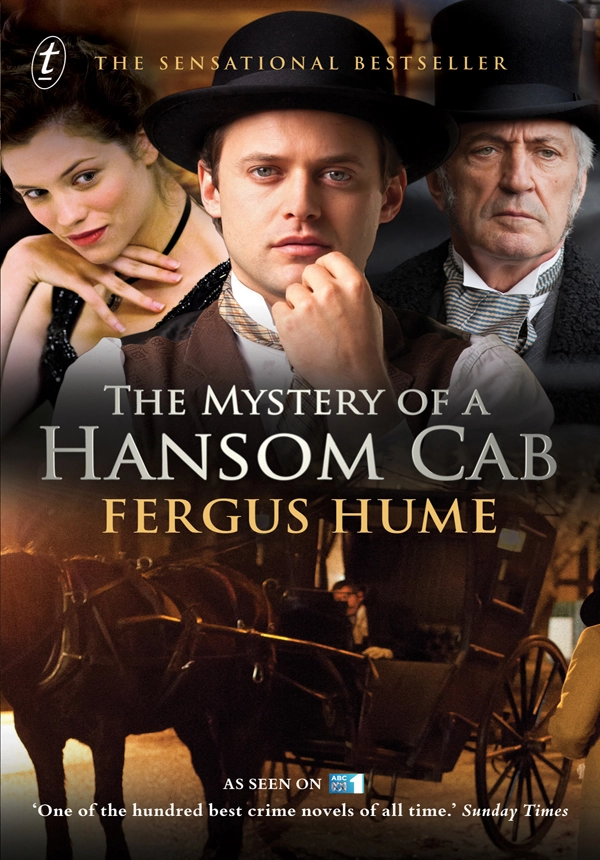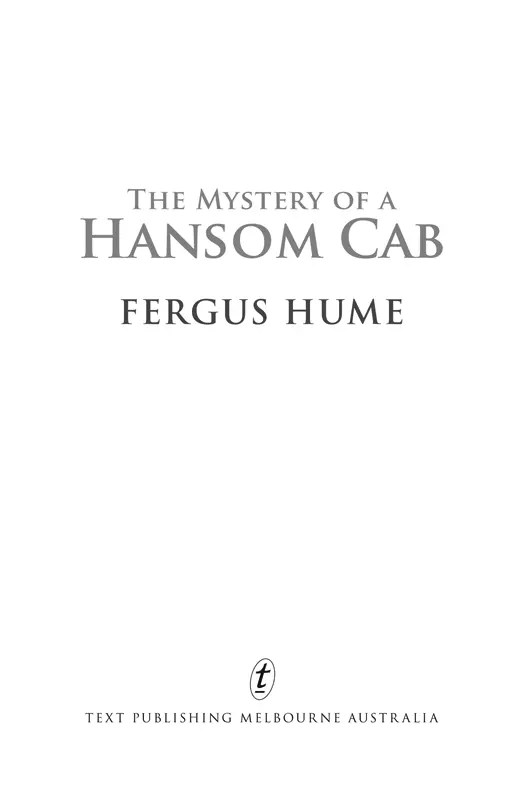The Mystery of a Hansom Cab

PRAISE FOR THE MYSTERY OF A HANSOM CAB
‘The novel was a phenomenal success when it was first published in Melbourne in 1886 and it became an international bestseller…It’s easy to see why. The plot sweeps through unexpected twists and turns…and the suspense is maintained to the end…Most appealing…is the wonderful flavour of the 1880s Melbourne, from the gaslit glamour of the Collins Street “block” to the hideous squalor of the slum alleys off Little Bourke Street…A splendidly romantic melodrama, full of period charm, and victorian sentiment…The Mystery of a Hansom Cab is not only a classic but thugely enjoyable as well.’
West Australian
‘Australia’s original blockbuster is back in print. Written more than 100 years ago, this murder mystery sold hundreds of thousands of copies around the world…It will give you a wonderful sense of Melbourne’s history—you’ll hear the hansoms rattling down Collins Street for weeks afterwards.’
Herald Sun
‘Full credit to Text Publishing for rescuing Hume’s first and best known book from obscurity, for this is more than just an historical curiosity; it’s a well written and immensely readable detective story.’
Daily Telegraph
‘It’s an absolute ripper…there’s a grisly murder by an unknown assassin, a plot full of astonishing twists and turns, and a brilliant evocation of 19th-century Melbourne that captures its charm, bustle and rawness.’
Inside Melbourne
‘In charmingly genteel, high-society Melbourne, murder 1880s-style is stealthily plotted. No phone-tapping or planted bombs, just hand-delivered notes, horse-drawn carts and a deadly dose of chloroform…More readable than ever.’
Examiner
FERGUS HUME was born in England in 1859. His family soon immigrated
to New Zealand, where Hume qualified as a lawyer. He was admitted to
the bar in 1885 and moved to Melbourne in the same year.
Desperate to become a playwright but having no success, Hume
decided to write a murder novel instead. When he couldn’t find a publisher
for The Mystery of a Hansom Cab he published it himself. It was a
sensation and sold over twenty thousand copies in Melbourne.
With a hit on his hands, Hume sold his copyright to the Hansom
Cab Publishing Company in London for fifty pounds. The book was
a phenomenal success but Hume never saw another penny from his
bestseller. It may have influenced Sir Arthur Conan Doyle’s A Study in
Scarlet, the first Sherlock Holmes adventure.
Hume moved back to England in 1888 after the publication of his
second novel, Madame Midas. He embarked on a career that produced
over 130 novels. He never became a famous playwright but he did co-write
the theatrical adaptation of The Mystery of a Hansom Cab, which played
in London for five hundred nights. The story was also filmed three times
in the silent era.
Fergus Hume died in 1932.
SIMON CATERSON is a Melbourne-based freelance writer and the author of Hoax Nation: Australian Fakes and Frauds from Plato to Norma Khouri.
ALSO BY FERGUS HUME
Madame Midas
The Silent House
The Moth-Woman
The Whispering Lane
The Caravan Mystery
The Last Straw

EDITOR'S ACKNOWLEDGMENTS
Thanks are due to Dr Alan Dilnot of the Department of English at Monash University and to the Rare Books staff at the Baillieu Library, University of Melbourne.
textpublishing.com.au
The Text Publishing Company
Swann House
22 William Street
Melbourne Victoria 3000
Australia
Introduction copyright © Simon Caterson 1999
Every effort has been made to trace copyright holders and obtain permission for the use of copyright material. The publisher apologises for any errors or omissions and would be grateful if notified of any corrections that should be incorporated in future reprints or editions of this book.
All rights reserved. Without limiting the rights under copyright above, no part of this publication shall be reproduced, stored in or introduced into a retrieval system, or transmitted in any form or by any means (electronic, mechanical, photocopying, recording or otherwise), without the prior permission of both the copyright owner and the publisher of this book.
First published 1886
First edition published by The Text Publishing Company 1999
This edition published 2012
Page design by WH Chong
Cover art courtesy of ABC TV.
Ebook Production by Midland Typesetters Australia
Primary print ISBN: 9781922079534
Ebook ISBN: 9781921961816
CONTENTS
INTRODUCTION
Fergus Hume’s Startling Story by Simon Caterson
The Mystery of a Hansom Cab
FERGUS HUME’S STARTLING STORY
SIMON CATERSON
The best-selling crime novel of the nineteenth century was not written by Arthur Conan Doyle or Wilkie Collins. That distinction belongs to Fergus Hume’s The Mystery of a Hansom Cab, which appeared in the year before Sherlock Holmes made what was, by comparison, a rather unspectacular debut in A Study in Scarlet.
The Hansom Cab was an overnight sensation when published in Melbourne in 1886, and it rapidly found readers around the world, especially in Britain. As many as 750,000 copies were sold during Hume’s lifetime, nearly half that number within the first six months of publication in London in 1887.
Advertised in its first English edition as ‘a startling and realistic story of Melbourne social life’, The Hansom Cab was a first novel which had been written almost by accident and was self-published. Despite these modest beginnings the book became a huge international success and was translated into eleven languages. In its obituary for Hume in 1932, The Times was to note that ‘everybody read it eagerly and in fact it went all over the world’.
Over the past hundred years Hume’s remarkable achievement has been outshone by the work of his contemporaries and, like other pioneering works, his novel has been eclipsed by subsequent developments in the genre. The Hansom Cab is nevertheless significant historically and, more importantly, it remains highly readable.
Fergusson Wright Hume was an outsider in the city he anatomised. He was born in England to Scottish parents in 1859 and taken in his infancy to New Zealand. He studied law at the University of Otago and was called to the New Zealand Bar in 1885. Rather than go into legal practice, he emigrated to Melbourne and found work as a law clerk while attempting to further his theatrical ambitions.
By his own account, published as the preface to the revised 1896 edition of The Hansom Cab, Hume wanted to make his living writing plays but could find no theatre manager who would even look at his work. Hoping to make his name in another branch of writing, he asked a local bookseller ‘what style of book he sold most of’. The reply was the detective novels of the French writer Emile Gaboriau (1833–73) which feature Monsieur Lecoq, whose murky past, eccentric habits and genius for deduction make him a forerunner of Holmes and countless other fictional sleuths.
Hume set about buying up Gaboriau’s books, studied their method and became ‘determined to write a book of the same class; containing a mystery, a murder, and a description of low life in Melbourne’. His plotting, however, is much tighter than Gaboriau’s somewhat digressive narratives. Hume follows his exemplar mainly in his approach to realistic detail. Diligent in his research, Hume claimed to have ‘passed a great many nights’ in the city’s slums, ‘gathering material’.
The setting for the murder was inspired by a late-night journey taken in a hansom cab, a horse-drawn two-wheeled cabriolet for two passengers with the driver mounted behind and the reins going over the roof. Hume realised that this vehicle was perfectly designed for murder, since the crime could be concealed from the driver, the only potential witness.
Despite his ingenuity Hume found that ‘every one to whom I offered it refused to even look at the manuscript on the ground that no Colonial could write anything worth reading’.
1 comment